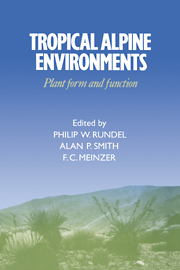Book contents
- Frontmatter
- Contents
- List of contributors
- Preface
- 1 Introduction to tropical alpine vegetation
- 2 Tropical alpine climates
- 3 Páramo microclimate and leaf thermal balance of Andean giant rosette plants
- 4 Comparative water relations of tropical alpine plants
- 5 Cold tolerance in tropical alpine plants
- 6 Anatomy of tropical alpine plants
- 7 Environmental biology of a tropical treeline species, Polylepis sericea
- 8 Morphological and physiological radiation in páramo Draba
- 9 Sediment-based carbon nutrition in tropical alpine Isoetes
- 10 Functional significance of inflorescence pubescence in tropical alpine species of Puya
- 11 Turnover and conservation of nutrients in the pachycaul Senecio keniodendron
- 12 Soil nutrient dynamics in East African alpine ecosystems
- 13 An overview of the reproductive biology of Espeletia (Asteraceae) in the Venezuelan Andes
- 14 Population biology of Mount Kenya lobelias
- 15 Population biology of Senecio keniodendron (Asteraceae), an Afroalpine giant rosette plant
- 16 Population dynamics and flowering in a Hawaiian alpine rosette plant, Argyroxiphium sandwicense
- 17 Plant form and function in alpine New Guinea
- 18 Alpine herbivory on Mount Kenya
- 19 Biotic interactions in Hawaiian high elevation ecosystems
- 20 Tropical alpine ecology: progress and priorities
- Index
14 - Population biology of Mount Kenya lobelias
Published online by Cambridge University Press: 21 October 2009
- Frontmatter
- Contents
- List of contributors
- Preface
- 1 Introduction to tropical alpine vegetation
- 2 Tropical alpine climates
- 3 Páramo microclimate and leaf thermal balance of Andean giant rosette plants
- 4 Comparative water relations of tropical alpine plants
- 5 Cold tolerance in tropical alpine plants
- 6 Anatomy of tropical alpine plants
- 7 Environmental biology of a tropical treeline species, Polylepis sericea
- 8 Morphological and physiological radiation in páramo Draba
- 9 Sediment-based carbon nutrition in tropical alpine Isoetes
- 10 Functional significance of inflorescence pubescence in tropical alpine species of Puya
- 11 Turnover and conservation of nutrients in the pachycaul Senecio keniodendron
- 12 Soil nutrient dynamics in East African alpine ecosystems
- 13 An overview of the reproductive biology of Espeletia (Asteraceae) in the Venezuelan Andes
- 14 Population biology of Mount Kenya lobelias
- 15 Population biology of Senecio keniodendron (Asteraceae), an Afroalpine giant rosette plant
- 16 Population dynamics and flowering in a Hawaiian alpine rosette plant, Argyroxiphium sandwicense
- 17 Plant form and function in alpine New Guinea
- 18 Alpine herbivory on Mount Kenya
- 19 Biotic interactions in Hawaiian high elevation ecosystems
- 20 Tropical alpine ecology: progress and priorities
- Index
Summary
Introduction
Tropical alpine environments impose unique selection pressures on plants, producing a number of special adaptations. Among these are caulescent and acaulescent rosettes, nyctinasty, semelparity, and resistance to nightly frost. For each of these adaptations there are a number of possible evolutionary explanations. To discriminate between among explanations, and to understand better tropical alpine environments in general, integrated long-term studies of particular species are necessary. Such studies include morphology, ecological physiology, demography and reproductive biology. Long-term population biology studies of tropical alpine plants are rare; most are presented in this volume. These studies are helping us to understand the nature of adaptation in tropical alpine environments.
Giant rosette plants make ideal research subjects for a number of reasons. They are conspicuous and characteristic members of virtually all tropical alpine communities. Their morphologically discrete form makes their growth and individual dynamics easy to quantify. Lastly, they are relatively long-lived, enabling us to examine the effects of long-term changes in local environment.
Since 1977, I have been studying two closely related giant rosette species on Mount Kenya, Lobelia telekii and L. keniensis. I present here a summary of the first 7 years of that study, concentrating on the comparative population biology of these two species.
A number of factors make Mount Kenya lobelias particularly attractive as research subjects. (i) The alpine environment of Mount Kenya is one of the most intensively studied ecosystems in the tropics (Hedberg 1957, 1964; Coe 1967; Coe & Foster 1972; Young & Peacock 1985; Young 1990a).
- Type
- Chapter
- Information
- Tropical Alpine EnvironmentsPlant Form and Function, pp. 251 - 272Publisher: Cambridge University PressPrint publication year: 1994
- 12
- Cited by



